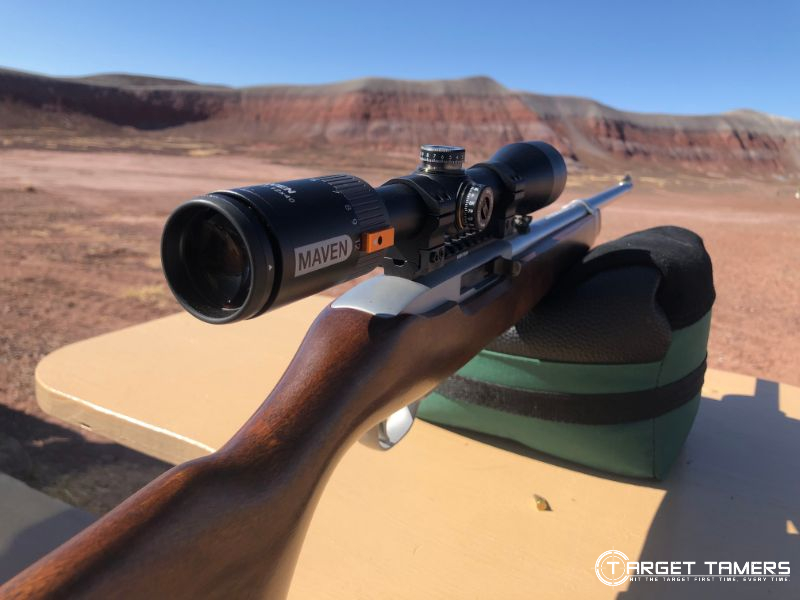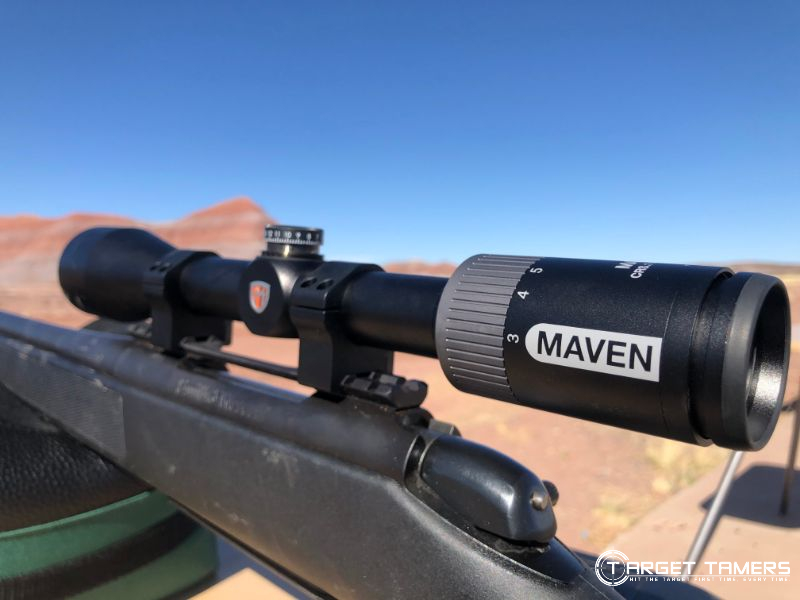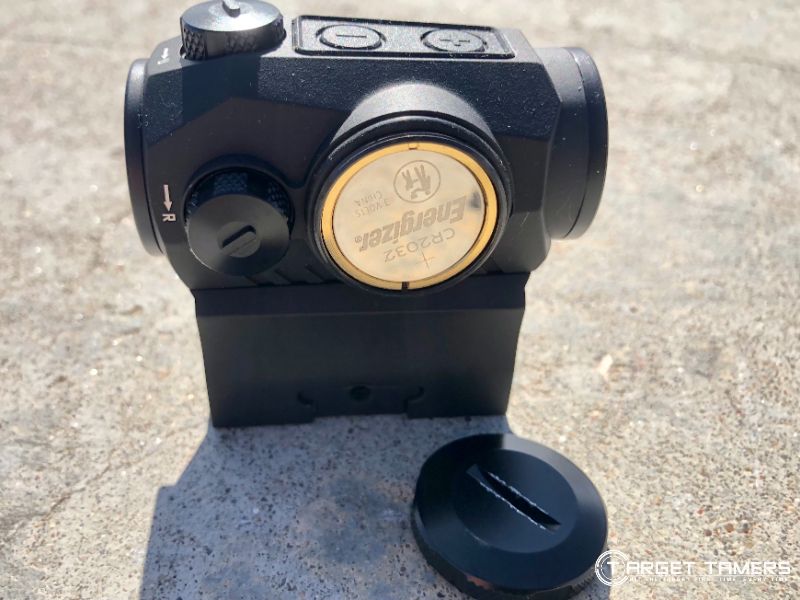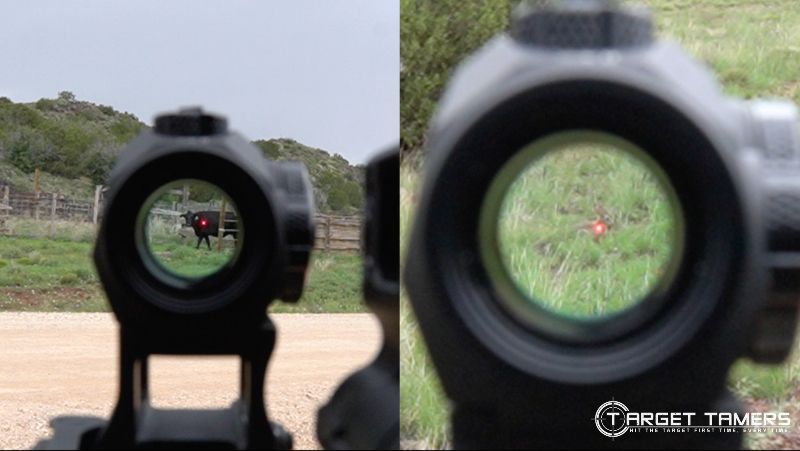Shooting a rimfire rifle is a favorite pastime of mine. But beyond just plinking for fun, there’s hunting and a competitive rimfire field.
The type of shooting you do with your Ruger 10/22, M&P 15-22, or Henry AR-7 will determine which is the best rimfire scope for your 22LR.
Since the .22LR is a plinking, hunting, and competition round, there’s a lot that it can do, but it also has its limitations.
With that said, I consider scope features that address parallax, close ranges, reticle type, focal plane, and of course, cost.
Let’s dig in!
Table of Contents
- The Best Rimfire Scopes for 22LR in 2024
- 1. Vortex Crossfire II 2-7×32 Rimfire – Best Overall
- 2. Maven CRS.1 3-12×40 – Best for Hunting
- 3. Burris FastFire 3 – Best Pistol Sight for .22LR
- 4. Sig Sauer Romeo 5 – Best Red Dot Sight for .22LR
- 5. Simmons .22 MAG 3-9×32 – Best Budget Scope
- 6. Vortex Diamondback 2-7×35 Rimfire – Best for Close-Range
- 7. Leupold VX-Freedom 3-9×40 Rimfire MOA – Best for Long-Range
- A Guide to Choosing the Best Rimfire Scope for 22LR
- FAQ’s
- Top Rimfire .22LR Scope: Which is Best?
The Best Rimfire Scopes for 22LR in 2024
1. Vortex Crossfire II 2-7×32 Rimfire – Best Overall
One of the most popular scopes rated by the masses is the Vortex Crossfire II. This particular model is the 2-7×32 Rimfire scope with the V-Plex (MOA) reticle. Simple, affordable, and accurate. It’s why it’s a heavy hitter in the rimfire scope market.
Pros:
- Cost
- V-Plex reticle
- SFP reticle
- Resettable turrets
- Fog/waterproof
Cons:
- No illumination
Not having illumination isn’t necessarily a bad thing, but come low light or dark targets in shaded areas (think squirrels), having a red aiming dot can be a great boon. The only reticle available in the Rimfire model for this configuration is the V-Plex.
Now the V-Plex is a great and simple hunting reticle. Whether you’re popping off cans or nailing jack rabbits, the V-Plex is easy to employ. The posts are 0.57 MOA in size with the center crosshairs 0.17 MOA in size. So, they’re small enough not to cover up vitals on rodents. With the reticle located in the second focal plane, you’ll always have a full-size view of the crosshairs even at minimum 2x magnification.
Having been outfitted for the rimfire cartridge, the parallax setting is fixed at 50 yards. This will be perfect for close quarter shots as well as some reach out to 100 yards.
With 0.25 MOA adjustments, resettable to zero turrets, and caps to set-‘em-and-forget-‘em, the Crossfire is accurate and couldn’t be simpler to sight-in and employ right away.
At under $150 street price (approx.), the Crossfire II riflescope is a quality buy for plinkers and hunters. With its high ratings across the board, the masses have spoken.
2. Maven CRS.1 3-12×40 – Best for Hunting
The Maven CRS.1 was made for hunters by hunters. It’s an excellent rifle scope that I mounted to a Ruger 10/22 just because I could. It meets cost, reticle, and magnification requirements I have for a hunting scope on a .22LR rifle.
Pros:
- Excellent glass
- 4x zoom magnification
- Fixed parallax
- 0.25 MOA adjustments
- CSHR SFP reticle
Cons:
- Clarity at 25 yards
The CRS.1 has fixed parallax at 100 yards, and the .22LR round can and will go that far. However, at 25 yards, the clarity is just shy of sharp – it’s marginally soft. Obviously, it’s strengths are at 50+ yards, but I also think it’s just fine for 25-50 yards too.
As a C-series optic, it has excellent glass quality – it’s something Maven is pretty good at. I wouldn’t hesitate to use this as a hunting scope on my .22 or elk rifles. During field-testing, I did just that by mounting it to my Ruger 10/22 and .270. I also put it on my AR-15. Just so you know, the bundle package includes rings!


The CRS.1 riflescope has 0.25 MOA adjustments, it tracks excellently, and I was extremely happy with my groupings and 100-yard zero.
The CSHR reticle is a simplified version of the SHR reticle. This one is made of wire, is bold and visible, and is in the second focal plane. This is something that hunters like because it’s highly visible at every magnification. Holdover values are 5, 10, and 20 MOA at 12x magnification.
If you wanted to put this scope on a different rifle, there’s nothing stopping you from doing so. The build quality is solid. The warranty is proven. The CRS.1 would be a high-quality scope for a .22LR.
3. Burris FastFire 3 – Best Pistol Sight for .22LR
Compact, fast, and convenient. The Burris FastFire 3 is a micro red dot sight ideal for the pistol in .22LR. Even though it mounts to handgun slides, it also comes with a Picatinny base in the box for mounting to a rifle rail.
Pros:
- 8 MOA dot
- Dynamic illumination
- Manual illumination
- Sunshade cover
- Picatinny rail mount
Cons:
- Battery compartment lid
First time shooting with the Burris FF3, I had an oopsie kind of moment. I didn’t secure the battery compartment lid properly, and it came off when I shot a round. That was an epic user fail in my books, and fortunately, I’m more aware of that now.



I really like the compact size of the pistol sight. It’s around 1.9” in length and weighs a mere 1.5 oz. Though it’s tiny, it’s built like a tank. I racked the slide multiple times against a wooden bench leaving the Burris FastFire sight no worse for wear.
It has an 8 MOA dot powered by a CR1632 battery, defaults to dynamic (ambient) illumination, but it does have a manual 3-setting illumination override.


What makes this great for both .22 pistols and rifles is that it also comes with a Pic rail in the box. Yes, I’ve mounted it to a .22 rifle and had a blast. The large dot makes it easy to see and acquire in the field.
When it comes to cost, it’s cheaper than the field-tested Leupold DeltaPoint Pro (check out our comparison of the Fastfire 3 and the Deltapoint Pro here) and other alternatives from Trijicon and Sig Sauer. As a versatile red dot sight with no perceivable parallax issues, and it’s ideal for close-range work, it’s a winner.
4. Sig Sauer Romeo 5 – Best Red Dot Sight for .22LR
The Sig Sauer Romeo 5 is one of the most highly-rated and popular red dot sights in the market. It’s affordable, has MOTAC, and it’s just as good for the .22LR round as it is for the 5.56mm and more.
Pros:
- Price
- Red dot sight
- 2 MOA dot
- Multi-height mounting system
- Long battery life
Cons:
- Non-adjustable MOTAC
Since it’s a red dot sight, the Romeo 5 is often shot from my AR-15 rifles. It’s seen a lot of action on top a S&W M&P 15-22. My most recent complaint is that it somehow got stuck to my 5.56mm rifle rail. Long story short – a screw extractor set was necessary. So, don’t over-torque the tension!
What makes the Romeo 5 so popular is its motion-sensor feature, MOTAC. It automatically goes into stand-by mode after 120 seconds of non-use. When motion is detected, the illumination kicks on and the dot is ready and waiting for use by the time you get rifle to shoulder.


It has a 2 MOA dot which is great for close-range work as well as stretching the distance to say 175 yards for long shots with the .22LR round.
With a CR2032 battery powering the Sig sight, it has a 40,000+ hour battery runtime. After well over a year, I still haven’t changed it out yet.
Considering its low price point under $150, it’s one of the top red dot sights for the money. How could it not be a great pairing for a .22LR rifle?
5. Simmons .22 MAG 3-9×32 – Best Budget Scope
If you’re looking for a quality scope under $50 for a rimfire rifle, you must consider the Simmons .22 MAG 3-9×32. It’s about as basic as it gets as evident from its Truplex (duplex style) reticle to its fully coated lenses. But it’s a cheap scope that’s worth buying when the budget is limited.
Pros:
- Truplex reticle
- Rings included
- QTA eyepiece
- Lightweight
- Fog/waterproof
Cons:
- Included scope rings
It’s nice for a manufacturer to attempt to include all the components needed to get shooting out of the box, but unfortunately, it seems the included rings require a little work. This usually means some shimming or lapping them. Most people end up buying different rings.
With that out of the way, the .22 MAG scope is obviously made for rimfire rifles. Even with its 3-9×32 configuration, it’s one of the lightest riflescopes in this lot at 10 oz (approx.).
The 0.25 MOA turrets are finger adjustable and capped. There is a total of 60 MOA in adjustment travel for both the elevation and windage turrets.
Simmons highlights the QTA (Quick Target Acquisition) eyepiece that seems to be comparable to a quick focus eyepiece. Though you can adjust for your vision, the optics only have a fully coated treatment, so brightness and resolution will just be acceptable – not exquisite. However, I really like that it has a HydroShield lens coating for as cheap as this scope is.


Though you might hear of the .22 MAG scope having an AO or adjustable parallax feature – it does not! It has a fixed parallax setting for 50 yards.
Based on the optics and overall quality, it will be a standard performer for recreational applications. I’d say the Simmons scope will be a reasonable optic for plinking and maybe some small game hunting. For 50 bucks, it really can’t be beat.
6. Vortex Diamondback 2-7×35 Rimfire – Best for Close-Range
The Diamondback 2-7×35 Rimfire scope mightn’t seem like a far stretch from the Crossfire II 2-7×32 Rimfire. However, there are differences that could justify the jump up in price for the Diamondback.
Pros:
- Cost
- V-Plex reticle
- SFP reticle
- Resettable turrets
- Fog/waterproof
Cons:
- No illumination
As you can tell, the pros and cons are the same between the Diamondback and Crossfire II riflescopes. However, the differences are in the details. The Diamondback has a larger objective lens, wider FOV, and more adjustment travel with no consequence to size and weight. The real consequence is the increase in cost for these upgrades.
Like the Crossfire II, the Rimfire model has the V-Plex reticle. However, the Diamondback V-Plex Rimfire reticle is excellent in drawing the eye to the center with 1 MOA size posts and even thinner 0.3 MOA center crosshairs. This V-Plex is thicker than the Crossfire II V-Plex!
This is great especially for those with aging vision. However, without an option for illumination, there’s only so much you can do in low-light and against dark, shaded terrains.
For most people, this is not always an issue. The benefits of having a simple reticle, resettable to zero turrets, finger adjustments, and a Vortex-tough build are worth it. Focus should not be an issue from 0-100 yards as parallax is set to 50 yards – the perfect middle-ground for all things rimfire.
With the famous VIP warranty to back the scope, there’s little to dislike about the Vortex rimfire scope.
7. Leupold VX-Freedom 3-9×40 Rimfire MOA – Best for Long-Range
The Leupold VX-Freedom series is a well-known and affordable line of scopes from Leupold. The 3-9×40 model incorporates a traditional configuration but adds a unique touch with the Rimfire MOA reticle to hit long-range targets with 3x zoom.
Pros:
- Rimfire MOA reticle
- Finger-click adjustments
- 0.25 MOA adjustments
- 60-yard fixed parallax
- Fog/waterproof
Cons:
- No illumination
The bold lines of the reticle are 1 MOA while the hashmarks are 0.25 MOA in size. This is good for minimal subtension on targets, and should be easy for old eyes to see – even in low light though it lacks illumination.
Apparently, the VX-Freedom series of riflescopes are designed, machined, and assembled in the USA. Short way of saying it, it’s made in the USA. It’s fog, shock, and waterproof, and although it’s going to be excellent for the 22LR, it’ll certainly handle recoil from sitting on a centerfire rifle.


What makes it perfect for the .22 is the unique Rimfire MOA reticle. Sitting in the second focal plane, subtension is only accurate at max 9x power. The 3:1 ratio zoom (3X) provides 3-9x variable magnification that used to be the standard for most applications. Now, the 4x 3-12x configuration is replacing the one-time standard. I’d consider the 3-9x a traditional platform that has proven its worth time and time again.
Though simple in design and application, the VX Freedom scope has finger-click adjustments in 0.25 MOA increments. It has fixed parallax of 60 yards which is a great setting considering the average distance shots for a .22.
Made to be ideal for the .22 in reticle, focus, and ease of use, the Leupold VX-Freedom could be a top scope for competition and long-range shots.
A Guide to Choosing the Best Rimfire Scope for 22LR
Cost
On average, any riflescope can be used on a rimfire rifle. Rimfire scope features include reticle type, close-range focus, and usually an overall theme of simplicity. This generally results in a scope that is affordable with low to mid-range magnification, and fixed parallax of 50 or 60 yards.
Scope Type for 22LR
Overall, there is a plethora of .22LR firearms from handguns to carbine pistols, flat-top ARs, and bolt and lever action rifles. This provides a wide variety of optic options to mount to a firearm with the .22LR cartridge.
The nice thing about these types of scopes is that they can be used on 17 HMR to even some or all centerfire cartridge firearms too (depending on quality and application of course).
Some of the best types of optics to mount to your 22 may depend on the firearm. For example, a red dot sight could be best for an AR-15 while a scope would be fantastic for the bolt-action rifle.
Reticle
In general, most shooters are not concerned with bullet drop and may just hold over for distances that they’ve memorized. Most scopes designed for the rimfire cartridge will have a simple, duplex reticle. More complex rimfire reticles offer BDC features for drop and wind holdovers.
The BDC (Bullet Drop Compensation) reticles are nice to have for those that are taking long shots out to 200 yards or sometimes more.
Additionally, most scopes are set in the SFP (Second Focal Plane). The reticle and crosshairs remain at full size throughout the entire magnification range.
For more info on reticle types, check out our reticles guide. For more info on FFP VS SFP, we have a guide on focal planes too!
Focus/Parallax
Many centerfire riflescopes that have fixed parallax will have the focus set at around 100-150 yards. Since this is usually the max distance when shooting .22LR rounds, this can make it slightly inconvenient when shooting inside 100 yards and as close as 10 yards.
As a result, most rimfire scopes have a parallax setting of between 10-100 yards with the average at 50 and 60 yards. This provides clarity throughout the entire magnification range and minimizes the effects of parallax.
Of course, you can always practice a consistent cheekweld to peer down the optical axis of the scope to eliminate parallax completely, but you can read more about that in this scope parallax guide.
Warranty
Not all riflescope warranties are equal. Some manufacturers have a warranty that precedes them for their unconditional coverage while others have limitations that can prevent cost-free repairs or resale. Regardless of how much is spent on a riflescope, a good warranty is always worth looking into.
FAQ’s
Top Rimfire .22LR Scope: Which is Best?
There are a lot of rimfire scopes that are perfect for the .22 LR. Setting the budget would help to narrow down the list, and from there, other features can be determined to be suitable and appropriate or unnecessary.
The takeaway is that a rimfire scope has features suited to a rimfire firearm. Sure, you can put a Vortex Razor or NightForce ATACR on there, but I’d say it’s overkill.
Usually, the best scope for a .22 is the one that will get used, maximizes fun in the field or at the range, and doesn’t cost you an arm and a leg.
Further Reading
- Ozark Armament Rhino 4x Prism Sight Review (Range Tested)
- Ozark Armament Rhino Red Dot Sight Review (Range Tested)
- How to Measure Scope Ring Height (With Pics & Calculations)
- How to Adjust a Rifle Scope: 6 Scope Adjustments Explained!
- How to Level a Scope on a Rifle [Step-by-Step With Pics]











































